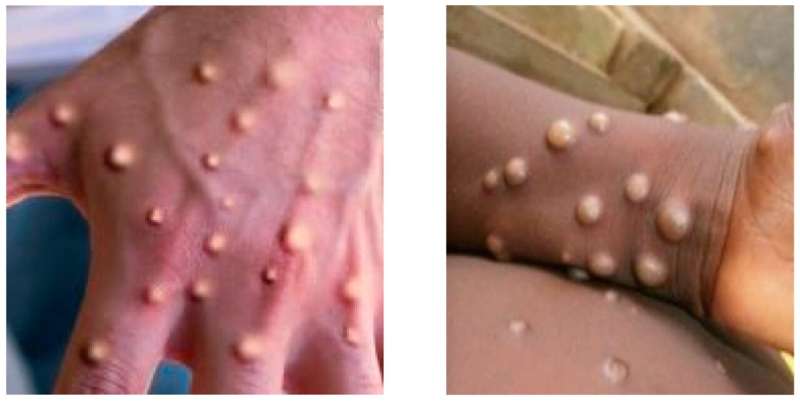This article has been reviewed according to Science X's editorial process and policies. Editors have highlighted the following attributes while ensuring the content's credibility:
fact-checked
trusted source
proofread
Scientists develop model to distinguish between two strikingly similar diseases blamed for skin lesions

Scientists have developed a deep learning (DL) model capable of quickly and accurately distinguishing between monkeypox and chickenpox skin lesions, which often exhibit striking similarities.
People developing pox-like rashes are normally confused about whether they are caused by chickenpox or monkeypox. Even medically, it is sometimes hard to tell them apart particularly when circulating together in areas lacking advanced diagnostic medical devices.
Dr. Dilber Uzun Ozsahin, University of Sharjah's Associate Professor of Medical Diagnostic Imaging, and the study's lead author, describes the model as a "breakthrough that holds crucial implications for the early detection of monkeypox, facilitating timely treatment and outbreak prevention."
"Given the challenges of misdiagnosis, especially in endemic regions with limited expertise, our model offers a significant breakthrough," Dr. Ozsahin says, adding. "In regions with limited expertise, our model provides a significant breakthrough. We used artificial intelligence to train the model on a limited dataset due to the rarity of these diseases, achieving remarkable accuracy and minimizing false diagnoses."
Dr. Ozsahin's team includes scientists from the U.S., Turkey, and Spain. They have published their model in journal Diagnostics.
Medical research leaning on deep learning algorithms currently holds promise for rapid and accurate diagnosis and effective treatment of various diseases. Using two open-sourced digital skin images for monkeypox and chickenpox, the authors attempt "to integrate a well-trained DL algorithm to assist in the early detection and classification of skin lesions in human subjects."
A two-dimensional convolutional neural network (CNN) consisting of four convolutional layers was applied. Afterward, three MaxPooling layers were used after the second, third, and fourth convolutional layers."
Then, the authors examine the performance of their model with what they call "state-of-the-art deep learning models for skin lesions detection," adding that their "proposed CNN model outperformed all DL models with a test accuracy of 99.60%."
"The resemblance in skin lesions in the human subject may disrupt effective diagnosis and, as a result, lead to misdiagnosis. Such misdiagnosis can lead to the further spread of the disease as it is a communicable disease and can eventually result in an outbreak," the authors write.
Skin lesions are the most prominent symptoms of pox-like diseases, but those created by monkeypox, and chickenpox almost look alike when afflicting the human body. Their resemblance makes it hard to set them apart, the thing, the authors note, "may disrupt effective diagnosis and, as a result, lead to misdiagnosis of a communicable disease with the ability to circulate quickly."
Of the outcome of their study, the authors endow their model with the possibility of "accurately classifying commonly characterized skin lesions associated with monkeypox and chickenpox using a DL framework."
"With the current monkeypox outbreak, a DL approach can be implemented independently or with communicable disease experts in regions where the disease is endemic. This would be useful in the rapid detection of the disease. Hence, preventing preventable monkeypox and chickenpox outbreak in the future."
Asked about the significance of the project, Dr. Ozdahin says the model has "the potential to revolutionize the detection of monkeypox and chickenpox, aiding in early intervention and preventing disease outbreaks."
This is more so in regions where communicable disease experts are scarce, rendering misdiagnosis a common challenge. "The development of a reliable deep learning model opens new possibilities for independent or collaborative use with health care professionals in endemic areas, providing a rapid and accurate tool for disease detection," Dr. Ozdahin said.
The model once applied, according to Dr. Ozdahin, it is certain to have direct practical implications for the field of disease diagnosis, particularly in areas where monkeypox and chickenpox are prevalent.
"The developed deep learning model can assist health care professionals in accurately classifying skin lesions, enabling early identification of the diseases. This, in turn, can lead to prompt treatment, reducing the spread of infections and improving overall public health outcomes."
The research's potential impact, in the words of Dr. Ozdahin, goes beyond academia, where there has been notable interest by peers in the study. "The study provides a practical tool for health care professionals, paving the way for more effective disease detection and prevention.
"Our deep learning model represents a breakthrough in accurately identifying monkeypox and chickenpox, offering a reliable solution to the challenges of misdiagnosis in regions with limited health care expertise.
"By leveraging artificial intelligence, we aim to empower regions facing challenges in communicable disease diagnosis, contributing to a more resilient and responsive health care system."
More information: Dilber Uzun Ozsahin et al, Computer-Aided Detection and Classification of Monkeypox and Chickenpox Lesion in Human Subjects Using Deep Learning Framework, Diagnostics (2023). DOI: 10.3390/diagnostics13020292



















